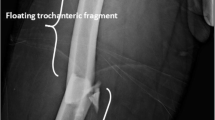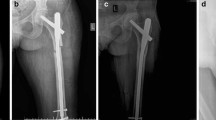Abstract
Treatment of reverse oblique trochanteric femoral fractures is still challenging. We present the results of our proximal nailing surgery performed for reverse obliquity intertrochanteric fractures using two lag screws and evaluated the quality of the reduction, operative time, complications and functional status of the patients. Fifteen patients with AO/OTA 31 A-A3 fractures were treated by proximal femoral nailing in our trauma centre. The mean Harris hip score was 74.66 (range 65–96) and the mean Barthel activity score was 15.71 (range 12–20). The mean duration of surgery was 48 minutes and the average consolidation time was 8.6 weeks. No intraoperative complications or postoperative technical failures and no stress shielding as evidenced by the lack of cortical hypertrophy at the level of the tip of the implant were detected. Intramedullary nailing with proximal femoral nails may be a good option in the treatment of reverse obliquity intertrochanteric fractures.



Similar content being viewed by others
References
Domingo L, Cecillia D, Herrera A et al (2001) Trochanteric fractures treated with a proximal femoral nail. Int Orthop 25:298–301
Haldar SC (1992) The Gamma nail for pertrochanteric fractures. J Bone Joint Surg 74-B:340–344
Leung KS, So WS, Shen WY et al (1992) Gamma nails and dynamic hip screws for pertrochanteric fractures. J Bone Joint Surg 74-B:345–351
Banan H, Al-Sabti A, Jimulia T et al (2002) The treatment of unstable extracapsuler hip fractures with AO/ASIF proximal femoral nail (PFN)—our first 60 cases. Injury 33:401–405
Boldin C, Seibert FJ, Frankhauser F et al (2003) The proximal femoral nail (PFN)—a minimal invasive treatment of unstable proximal femoral fractures: a prospective study of 55 patients with a follow-up of 15 months. Acta Orthop Scand 74:53–58
Kregor PJ, Obremsky WT, Kreder HI et al (2005) Evidence-based orthopaedic trauma working group. Unstable pertrochanteric femoral fractures. J Orthop Trauma 19:63–66
Min WK, Kim SY, Kim TK et al (2007) Proximal femoral nail for the treatment of reverse obliquity intertrochanteric fractures compared with gamma nail. J Trauma 63:1054–1060
Park SY, Yang KH, Yoo JH et al (2008) The treatment of reverse obliquity intertrochanteric fractures with the intramedullary hip nail. J Trauma 65:852–857
Sadowski C, Lübbeke A, Saudan M et al (2002) Treatment of reverse oblique and transverse intertrochanteric fractures with use of an intramedullary nail or a 95 degrees screw-plate: a prospective, randomized study. J Bone Joint Surg 84-A:372–381
Werner W, Llajter G, Schmiedhuber G (2002) Intra-und Komplikationen bei der Stabilisienung von Per- und Subtrochantaren Femur Fracturen Mittels PFN. Unfallchirurg 105:881–885
Ozkan K, Unay K, Demirçay C et al (2009) Distal unlocked proximal femoral intramedullary nailing for intertrochanteric femur fractures. Int Orthop 33:1397–1400
Mc Kibbin B (1978) The biology of fracture healing in long bones. J Bone Joint Surg 60-B:150–162
Simmermacher RK, Boch AM, de Werken V et al (1999) The AO/ASIF proximal femoral nail (PFN): new device for treatment of unstable proximal femoral fractures. Injury 30:327–332
Tyllianakis M, Panagopoulos A, Papadopoulos A et al (2004) Treatment of extracapsuler hip fractures with the proximal femoral nail (PFN): long term results in 45 patients. Acta Orthop Belg 70:444–454
Utrilla AL, Reig JS, Muñoz FM, Tufanisco CB (2005) Trochanteric gamma nail and compression hip screw for trochanteric fractures: a randomized, prospective, comparative study in 210 elderly patients with a new design of the gamma nail. J Orthop Trauma 19:229–233
Palm H, Jacobsen S, Sonne-Holm S, Gebuhr P, Hip Fracture Study Group (2007) Integrity of the lateral femoral wall in intertrochanteric hip fractures: an important predictor of a reoperation. J Bone Joint Surg Am 89:470–475
Lin J (2007) Encouraging results of treating femoral trochanteric with specially designed double-screw nails. J Trauma 63:866–874
Haidukewych GJ (2009) Intertrochanteric fractures: ten tips to improve results. J Bone Joint Surg Am 91:712–719
Kaplan K, Miyamoto R, Levine BR et al (2008) Surgical management of hip fractures: an evidence-based review of the literature. II: intertrochanteric fractures. J Am Acad Orthop Surg 16:665–673
Alexa O, Cozma T (2004) Compression hip screw fixation with bone cement in trochanteric fractures. Rev Med Chir Soc Med Nat Iasi 108:416–419
Conflict of interest
The authors declare that they have no conflict of interest.
Author information
Authors and Affiliations
Corresponding author
Rights and permissions
About this article
Cite this article
Ozkan, K., Eceviz, E., Unay, K. et al. Treatment of reverse oblique trochanteric femoral fractures with proximal femoral nail. International Orthopaedics (SICOT) 35, 595–598 (2011). https://doi.org/10.1007/s00264-010-1002-z
Received:
Revised:
Accepted:
Published:
Issue Date:
DOI: https://doi.org/10.1007/s00264-010-1002-z




